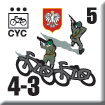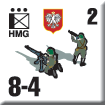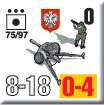| 1940: Polish Exiles
Scenario Preview, Part Three
By Mike Bennighof, Ph.D.
February 2024
 I have a vision. It’s not a fairly narrow vision, as visions go, but it’s an achievable one. I want to develop Panzer Grenadier: 1940 The Fall of France into the centerpiece of a deep dive into the story of the 1940 campaign in Western Europe, told in wargame form. I have a vision. It’s not a fairly narrow vision, as visions go, but it’s an achievable one. I want to develop Panzer Grenadier: 1940 The Fall of France into the centerpiece of a deep dive into the story of the 1940 campaign in Western Europe, told in wargame form.
We’ve published two complete games set in the campaign (The Fall of France and Road to Dunkirk, highlighting the French and British experience, respectively). We added more Gallo-centric scenarios in the Campaign Study, 1940: The Last Days of May, and a nice large expansion featuring the French 1st Moroccan Division, called 1940: Swallows of Death.
1940: Polish Exiles brings another fascinating part of the campaign to your game table (well, it fascinates me). Following the Nazi conquest of Poland in September 1939, the Polish government-in-exile formed an exile army to fight alongside the French. The response surprised everyone except the Poles, as soldiers who escaped the Nazis joined Poles residing in France and expatriates from around the world in this new army.
The Polish Army in France didn’t prevent the fall of their new host country; they entered combat after the campaign had been decided. But fighting Nazis (or their spiritual descendants) is never futile.
Let’s have a look at the third chapter’s scenarios.
Chapter Three
Polish Grenadiers
As French commander-in-chief Maxime Weygand ordered a withdrawal to a new line of defense in central France, Germany’s supreme leader Adolf Hitler issued Directive Number 15, ordering his forces to destroy the French Army. With an armistice looming, Hitler wanted as many French soldiers as possible in prisoner-of-war cages before that moment, rather than allowing them to return home.

A Polish horse-drawn supply column on a training exercise. Spring 1940.
That included the garrisons of the French Maginot Line, the modern concrete-and-steel fortresses protecting France’s eastern border. The Germans launched their Operation Tiger on 14 June, a direct assault on the Saar fortified sector. The French high command agreed to abandon the fortifications and re-deploy the garrisons to help block the German advance southward, but their retreat route had to be kept open by fresh reinforcements.
Those would include the Polish 1st Grenadier Division, finally deployed to the front on the morning of the 14th, with its artillery opening fire that afternoon in support of French units. The Poles had signed up to fight the Germans alongside the French, but quickly discovered that they had been sacrificed to cover a large-scale French withdrawal.
Scenario Ten
Grenadiers in Action
16 June 1940
Dieuze, France
 For two days, the Poles saw very few Germans, and some of their officers questioned whether their French-directed artillery barrages had any target at all, as they drew no counter-battery fire. As they covered the French withdrawal to the Marne-Rhine canal, German motorized units began to overtake and isolate the Polish rearguards Soon the remaining detachments were fighting and splitting up into less coordinated packs. Many men fell to the Germans as they strayed along the Lorraine roads. For two days, the Poles saw very few Germans, and some of their officers questioned whether their French-directed artillery barrages had any target at all, as they drew no counter-battery fire. As they covered the French withdrawal to the Marne-Rhine canal, German motorized units began to overtake and isolate the Polish rearguards Soon the remaining detachments were fighting and splitting up into less coordinated packs. Many men fell to the Germans as they strayed along the Lorraine roads.
On 16 June, the French 45th Corps ordered the 1st Polish Grenadier Division to gain a few hours by holding the Bénestroff-Mittersheim railroad line, before falling back on an intermediate defense line centered on the small town of Dieuze. The 3rd Battalion of the 2nd Grenadier Regiment would be reinforced by scattered French units.
At 1000, the Germans attacked the northern part of Bénestroff. After repelling the first attack for the first time, the Franco-Polish group retreated to the next blocking position, below Bédestroff a few kilometers to the south. On the left flank, the French 291st Infantry Regiment gave way fairly easily and retreated in disorder. On the right, the Germans occupied Bassing before 1100. Before being surrounded, the Poles escaped towards the Bride forest (to the south-west) under the cover of a French motorcycle squadron and anti-tank units, having suffered nine killed, around 20 wounded and 12 missing). They would make their stand at Dieuze.
Conclusion
The Polish 2nd Grenadier Regiment’s II Battalion held the Bois de St-Jean to the south of Dieuze, blocking passage between the town and the Lindre ponds to the east. On the German side, the II Battalion of the 499th Infantry Regiment reached Dieuze via the Vergaville road (D22) in the early afternoon, earlier than planned thank to requisitioned motor vehicles. Together with a French battalion, the Polish artillery shelled the German motorcyclists and then destroyed the trucks loaded with troops approaching the town.
The reinforced Germans attacked again around 1500, driving the Polish outposts from the Lindre hills overlooking the ponds. The attack overwhelmed the 88th Chasseurs à Pied Battalion of the 52nd Infantry Division. Its chasseurs withdrew after brief street battles, but lost two isolated companies at Guéblange. Their rout uncovered the Polish left wing, which was only saved by the massive intervention of the Polish artillery group.
The Germans resumed their attack at 1700. Preceded by an artillery barrage and supported by an armored car company, it badly mauled the Polish 7th Company, which suffered heavy losses. The situation was less critical on the left flank, where the 5th Company held its ground. Checked for a second time, the Germans continued to harass the Poles until nightfall.
The Germans were not concerned with clearing forests and isolated villages; their objective was to seize the main routes, which is why they launched forward motorized detachments with armored cars, motorcyclists, assault guns and light flak, followed by trucks loaded with infantrymen. On June 16, a similar formation attacked the bicycle company of the 348th Infantry Regiment, which was blocking the road to Dieuze. They held out for a few hours before giving in. On the right, the Polish regiment’s 3rd Battalion was driven back to Guebling with losses. On the left, despite support from the 75s, the 3rd Battalion of the French 291st Infantry Regiment collapsed and its companies were isolated. One of them retreated across the countryside to cross the canal, while another barricaded itself in Dieuze. Isolated infantrymen and chasseurs took refuge in houses as well.
From Hill 254, south of the town, French and Polish artillerymen had a superb observatory. They demolished trucks on the road from Bergaville to Dieuze. At the entrance to the town, elements of the French 75th Infantry Division finally halted the German advance in a street fight.
Notes
It’s a Polish-French delaying action, against a German infantry division that’s managed to partially motorize itself with captured French trucks. The Poles are very willing to fight the Nazis; the French are close to calling it a day. But the Germans have to accomplish quite a lot if they wish to win this one.
Scenario Eleven
Marne-Rhine Canal
17 June 1940
Lagarde, France
 In the morning, the Germans pushed through the remnants of Polish units around Dieuze, eliminating almost an entire Polish battalion, and reached the Marne-Rhine canal at around 1000. At midday, the first assault troops from the 488th Infantry Regiment entered the canal-side village of Lagarde, joined an hour later by motorized elements of the 499th Infantry Regiment. In the morning, the Germans pushed through the remnants of Polish units around Dieuze, eliminating almost an entire Polish battalion, and reached the Marne-Rhine canal at around 1000. At midday, the first assault troops from the 488th Infantry Regiment entered the canal-side village of Lagarde, joined an hour later by motorized elements of the 499th Infantry Regiment.
The German 268 Infantry Division’s objective, to conquer a passage over the canal, had almost been achieved. But Polish sappers blew up the Lagarde bridge, although the structure’s remains still allowed infantry to pass. German pioneers could reinforce the structure, but not while Lagarde remained under Polish artillery fire. The Polish grenadiers on the south bank of the canal awaited the opportunity to decimate any reckless German crossing.
Lacking artillery support, the Germans pushed the 499th Regiment’s I Battalion across the bridge, towards Vaucourt, in the direction of the Bois du Tilleul. The Poles retreated, but then rallied, gathering all available troops and counter-attacking. The Germans suffered heavy losses under Polish artillery fire and themselves retreated towards the canal, despite an attempted reinforcement by regiment’s II Battalion. By late afternoon, the Germans only had a small bridgehead across the canal. At dusk, the Poles counter-attacked.
Conclusion
Col. Wladyslaw Zietkiewicz of the 2nd Grenadier Regiment led the Polish counter-attack to eliminate the German bridgehead, starting at 2045. Duch, the division commander, had assembled a reserve including the divisional reconnaissance unit,
the remnants of the 1st Grenadier Regiment (around 200 men) and the Chodzko Corps Franc. The French 20th Tank Battalion offered 25 R35 light tanks to support the attack, but the commanders of the two armored companies were reluctant to take part. Galvanized by the strength of the Polish artillery and the presence of Zietkiewicz at their head, the Polish grenadiers attacked the German bridgehead with a howl, forcing a rapid retreat. The shooting ceased around midnight, and the Poles claimed that the bridgehead had been completely recaptured, which the Germans disputed. According to the German division’s chief of staff, “a small pocket remained in our hands south of the canal.” The charismatic Zietkiewicz would be murdered by Germans on the 21st.
Notes
The Germans have just gotten across the river, and now the Poles are counter-attacking to throw them back. The Poles have numbers, morale and even firepower on their side, but those advantages as always mean they have to get a lot done in order to claim victory.
Scenario Twelve
For Warsaw!
18 June 1940
Lagarde, France
 As a result of Polish artillery fire, the German pioneers were unable to repair the Lagarde bridge during the night, and their troops entrenched behind the Marne-Rhine canal suffered fairly heavy losses. On the other side, Poles held the south bank, at the edge of the forest, and stood ready for battle. German artillery support would not be available until midday, but Lt. Gen. Erich Straube, commanding the 268th Infantry Division, could not wait: he wanted his unit to be the first to cross the canal. Against all logic, the Germans resumed the same attack as the day before. As a result of Polish artillery fire, the German pioneers were unable to repair the Lagarde bridge during the night, and their troops entrenched behind the Marne-Rhine canal suffered fairly heavy losses. On the other side, Poles held the south bank, at the edge of the forest, and stood ready for battle. German artillery support would not be available until midday, but Lt. Gen. Erich Straube, commanding the 268th Infantry Division, could not wait: he wanted his unit to be the first to cross the canal. Against all logic, the Germans resumed the same attack as the day before.
Conclusion
As on the previous day, Polish machine guns hidden on the edge of the Bois du Tilleul opened fire on the attackers when they came into the open. A German company managed to get as close as 300 meters to the defensive lines, but could not get across a stream. In front of the Tuilerie farm, the attackers' losses began to mount. The assaulting pioneers withdrew, taking their leader's body with them, and an infantry company soon followed suit.
A rolling artillery barrage heralded a Polish counter-attack. Officers in the lead, bayonets fixed, the grenadiers threw themselves into hand-to-hand combat of rare intensity. To the Germans’ “Hurrah!” the Poles replied “For Warsaw! For Warsaw!” The Polish charge threw the Germans out of the forest, and though they returned after an hour, the stubborn Poles reoccupied part of the ground with superhuman efforts. After more than three hours of fighting, it was clear that the Germans had failed again. The battalion brought back more than 80 wounded, leaving 34 killed along the roadside.
Shortly after 1400, the German artillery finally joined the battle and silenced most of the Polish machine guns. As the Lagarde bridge finally opened up to vehicles, the armored cars moved over to the south bank. With all this support, the Germans dashed back up the slope into the forest and overwhelmed the grenadiers within an hour. The battle for the canal was finally over. The silent forest was now home to nothing but the dead and dying, amidst the shredded trees.
Notes
It’s another fight along the river, with both sides called on to attack. The Poles would seem to have the edge here, with their Polish morale, but the weight of metal lies on the German side of the river this time. This is going to be tough to win.
And that is all for Chapter Three!
You can order 1940: Polish Exiles right here.
Polish-Lithuanian Commonwealth
The Deluge
Lithuania's Iron Wolves
Legend of the Iron Wolf
1940: Polish Exiles
Retail Price: $90.96
Package Price: $70
Gold Club Price: $56
You can join the Commonwealth right here.
Sign up for our newsletter right here. Your info will never be sold or transferred; we'll just use it to update you on new games and new offers.
Mike Bennighof is president of Avalanche Press and holds a doctorate in history from Emory University. A Fulbright Scholar and NASA Journalist in Space finalist, he has published a great many books, games and articles on historical subjects; people are saying that some of them are actually good.
He lives in Birmingham, Alabama with his wife, three children, and new puppy. He misses his lizard-hunting Iron Dog, Leopold.
Want to keep Daily Content free of third-party ads? You can send us some love (and cash) through this link right here.
|
